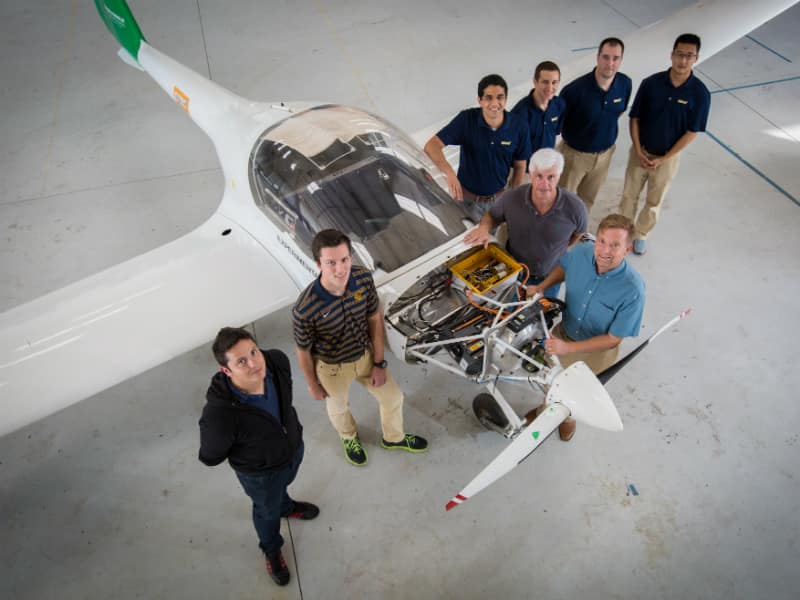Eagle Flight Goes Electric

Researchers at Embry-Riddle Aeronautical University’s Eagle Flight Research Center (EFRC) are working with a consortium of aerospace companies to develop a hybrid gasoline-electric propulsion system that will reduce the noise, emissions and operating costs associated with commercial aviation.
Their ultimate goal is to have a nine-passenger hybrid turboprop aircraft in production by 2025, and a large hybrid-electric jet, akin to a Boeing 737, by 2035.
It’s an ambitious vision, but the EFRC is already well on its way with several patents and an established record of successful hands-on hybrid and electric aircraft projects that provide the basis for two paper studies into the feasibility of hybrid aircraft.
For their current project, the EFRC is outfitting a Diamond HK-36, donated by Lockheed Martin Skunkworks, with a fully electric propulsion system. Christened the eSpirit of St. Louis, the pioneering aircraft will help the team develop a better understanding of the electric side of the hybrid propulsion equation — a key challenge in developing a viable hybrid propulsion system for aviation.
HEAVY LIFTING
Electric propulsion is attractive as an alternative to gas for a number of reasons: It’s cleaner and typically more cost effective. It’s also quieter, which, surprisingly, is what makes it so appealing to the industry.
Erik Lindbergh, CEO of Powering Imagination and grandson of aviation legend Charles Lindbergh, is closely involved in Embry-Riddle’s electric and hybrid aircraft efforts. Lindbergh joined with the EFRC to create the Quiet Flight Initiative, and says low-noise flight is the biggest factor for the industry players involved.
“We thought their reasons would be reducing emissions and operating costs, but we found out that noise is seen as the biggest threat to the industry,” Lindbergh says.
Electric propulsion may help provide an answer for reducing noise, but it still has one major problem: It’s much heavier than its gas counterpart.
Storing electrical energy on something that flies is not simple. The electric motor in the eSpirit is a pizza-sized, puck-shaped axial-flux machine that’s much lighter than the piston engine it replaces, but the batteries that power it are another story. Presently, three thick, orange power cables connect the motor to a ground-based battery pack weighing 800 pounds.
The weight and volume of the ground test battery is the biggest barrier to electric flight. “You can choose two of three things when it comes to batteries: cheap, small or light. Automotive batteries are cheap and small,” says Richard “Pat” Anderson, professor of aerospace engineering and EFRC lab director. “We are 100 percent focused on weight, but there’s no one trying to make batteries lighter.” The eSpirit team is currently charged with designing and testing a battery pack to meet the airplane’s requirements for takeoff and sustained flight.
While a viable battery could propel the eSpirit, the prospect for fully electric commercial aviation is dimmer. The amount of energy stored in each pound of batteries is very low compared to liquid fuel — and will be for the foreseeable future, Anderson says. This places a practical barrier to fully electric aviation at about 200 knots — slower than nearly all commercial flight. Because of this, Anderson believes all bigger airplanes of the future will have to be hybrids to reach and sustain commercial aviation speeds while taking advantage of the efficiency gains from electric propulsion.
“There are no large or fast electric airplanes because it’s not really possible right now,” Anderson says. “Gas turbine engines will always be the answer for maximum range until the specific energy of batteries exceeds liquid fuel. A lot of people don’t think that will ever happen.”
THE ELECTRIC EXPERIMENT
While all-out electric propulsion is a lofty goal, developing a functional hybrid turboprop won’t be easy either. There’s a lot of work left to do on the electric side of the gas-electric hybrid system, which is why the EFRC is building the eSpirit of St. Louis as a fully electric aircraft. Its experiments and test flights will provide much-needed data to design and optimize the hybrid system, says Lenny Gartenberg, a master’s student at Embry-Riddle.
Gartenberg is the project manager for the Hybrid Conceptual Design Tool (HCDT) being developed at the EFRC. When complete, the tool will be able to weigh factors such as efficiency, noise, range, emissions and cost to come up with the ideal batteries-to-fuel ratio and an optimized hybrid setup — whether that’s a parallel hybrid, a series hybrid or some combination of the two (see sidebar).
“We’re trying to develop the necessary models, retrieve the data required for these models and incorporate them into the HCDT. The data is widely available only for gas airplanes, so I am using data from our new electric airplane. We need to be able to model the electric end and then combine this with the gas to create one seamless process for how the two energy sources interact with each other,” Gartenberg says.
Most of these models have the potential to reduce carbon dioxide emissions, operating costs and noise when compared to their gas-only counterparts, in at least some scenarios, Anderson says. That makes hybrid aviation a viable technology for a sustainable future.
“Reduced fossil fuel usage is good for everybody on earth,” Anderson says. “The operating cost reduction means it’s probably a durable technology, meaning people won’t have to pay more money to do it. If we can get over the research hump, the other side is less expensive.”
FINDING THE HYBRID SWEET SPOT
There are many different ways to build a hybrid system, though they mostly stem from combinations of and variations on two basic types: serial and parallel systems. Each has its benefits and drawbacks.
In a serial (or series) hybrid system, a gas generator produces power for the electric motor, which in turn drives the propeller. This solution is optimal for reducing noise, but it can be less efficient than a direct-powered gas system, particularly when charging the batteries in flight.
In a typical parallel system, both a gas engine and an electric motor can directly drive the propeller. A parallel hybrid airplane could take off using the gas engine and cruise on electricity, making for quiet aerial flight. Or, when designed differently, it could take off on electric power, making for quieter takeoffs, and maximize range by switching to the gas engine when the batteries are exhausted. While potentially noisier than a serial system, a parallel system is more efficient than 100 percent gas-fueled systems in almost all cases.
There is still a lot of research ahead before Embry-Riddle’s Eagle Flight Research Center team can determine the ideal hybrid configuration to meet their goals, but its director, Richard “Pat” Anderson, believes all large commercial aircraft in the future will use hybrid propulsion to reduce noise, operating costs and fossil fuel consumption.
“We’ve been using an incremental method for the last 70-some odd years with [improving the efficiency of] jet engines. We can probably continue to economize at a 10th of a percent for years. But we have solutions with our hybrid systems that are in the 9 percent realm right now, and if we keep searching the design space, we can hopefully find better than 9 percent.”

 Alan Marcos Pinto Cesar
Alan Marcos Pinto Cesar